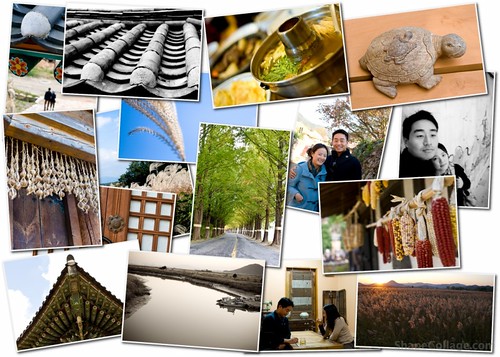
It has been several months since we came back from Korea. My apologies to those who've long waited for a new post. When I returned from the vacation, my absence at work had taken its toll on my workload and it kept me off blogging for awhile, despite we brought so many beautiful and delicious pictures from Korea that I want to share.
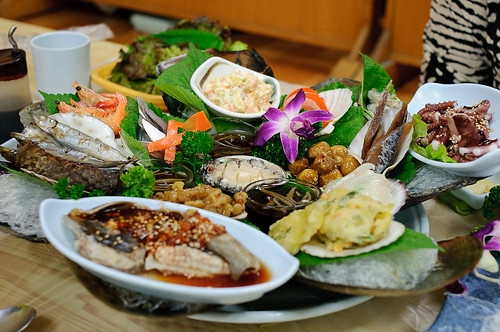
We had so much fun and had lots and lots of, maybe too much, foods. Foods were definitely highlights of our trip. Min and I were predetermined to take pictures of every single meal we have in Korea, and so we did. This is a picture of the first meal we had upon arriving in Korea. Min's relatives took us to a seafood restaurant in Wolgot on our way from the airport to Seoul. If you want to see the complete collection of our pictures from Korea, click here.
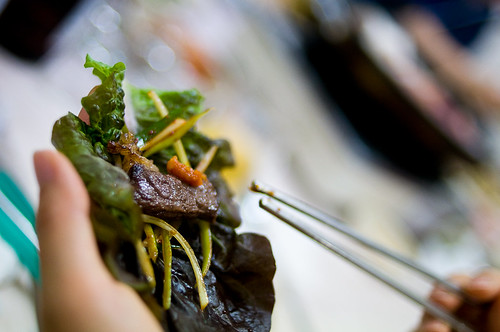
Let me start with Korean hanwoo beef, since it's one of the most celebrated cuisines in Korea. Similar to kobe beef of Japan, hanwoo is a luxurious delicacy of Korean beef which is famously known for its beautiful marbling, lean texture, and flavorful taste.
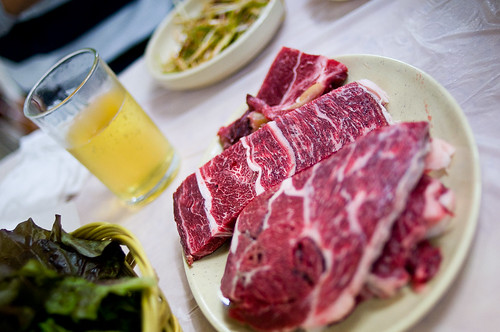
The meat was so lean that we had to use lard to pre-grease the BBQ grill. Hanwoo was expectedly delicious. Paired with a shot of soju and good old friends, nothing beats the whole dining experience.
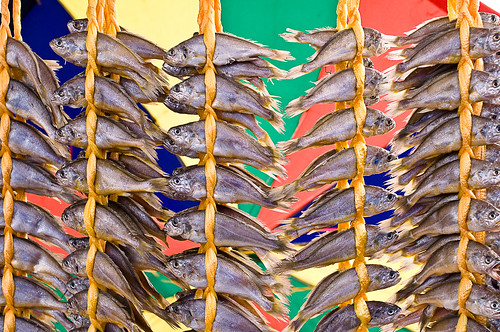
Yeongwang is best known for gulbi, a wind dried yellow corvina. It is said that the weather in Yeongwang is very unique and is perfect for drying corvina, such that the taste of gulbi from this region is the best across Korea and possibly in the world.
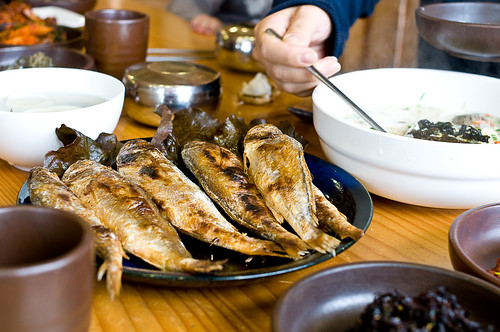
Here is a picture of gulbi course meal we had in Yeongwang.
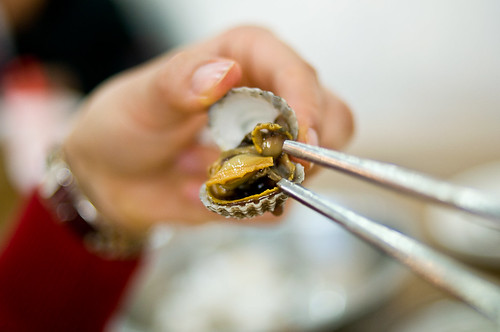
Cockles are very popular in Korea, but I noticed that they are not sold in many places in the US. So, when Min's uncle took us to a restaurant in Bulgyo which specializes in cockle dishes, Min and I were both delighted to try this exclusively Korean dish. Cockles were deliciously chewy and salty.

The restaurant Min's uncle took us (I forget the name, but it's located next to a post office in Bulgyo downtown) specializes anything made with cockles like cockle salad, cockle soup, cockle pancake, etc. Knowing we won't be able to have cockles once we return to the US, we savored each piece of cockles. We had so much cockles that we were in food coma after the meal.
Live mini-octopus dish is often featured on TV as one of the most exotic foods in the world. Min's aunt is from Mokpo, a region famous for this dish in Korea. When we were visiting, she shopped for some fresh live octopus in the early morning seafood market and basically served us for breakfast a dish of live octopus swimming in sesame oil topped with some green peppers.
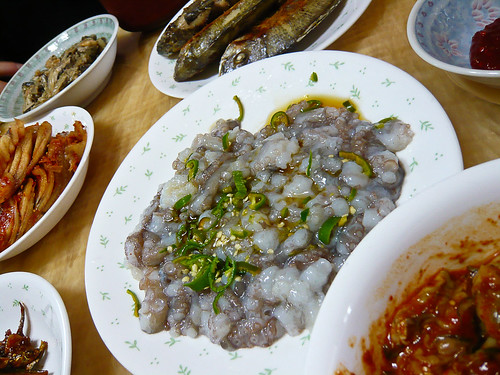
This was my first time trying this dish, or anything alive for that matter. It turned out I totally enjoyed it. The idea of eating something alive could be somewhat uncomfortable at first and you may call me being inhumane or crazy, but I find this dish very delicious and quite addictive.

This used to be both Min and my favorite beverage from Korea when we were growing up. It's banana flavored milk. I find many Korean Americans share the same kind of nostalgia whenever we see this drink packaged in the same old carton. I hope Bingrae continues to make this drink the same way as it has done ever since.

City of Jeonju boasts the rich heritage of royal influence and aristocratic culture which flourished under the Joseon dynasty. Located in the most fertile land in Korea, the city of Jeonju is also very famous for rich food culture, not to mention Bibimbap originates from this region. Our meal in Jeonju was also very impressive.
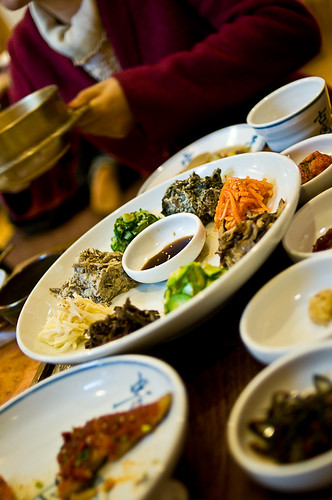
Thanks to my old roommate family from New York who now lives in Jeonju, we were treated to a famous restaurant which specializes in Korean royal cuisine. I can't remember how many dishes they brought out. There were so many that, as an old Korean saying goes, the table legs were about to break.
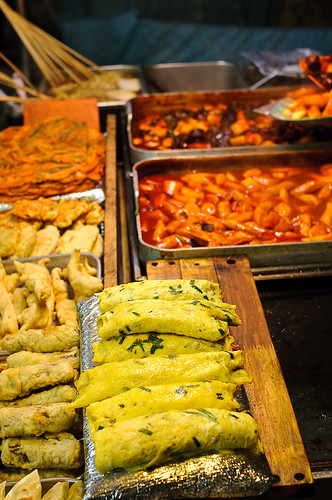
The street food culture in Korea goes unsurpassed. Street-foods are very popular in Korea because they are convenient and cheap. One day Min and I set out to the city specifically to try out street-foods in Seoul. Once we were out on the street, we realized there are so many street-food vendors on the street that it's not easy to make a decision on which cart to eat at. In some instances, we noticed there are more than ten vendors within one block, literally side by side, and they all looked good. We had to walk back and forth on the same block before we randomly chose one to seat in. Tteokbokki is a staple street-food menu, and I noticed each vendor has added unique dishes to their menu besides tteokbokki, such as egg-rolled kimchi pancake, tempura, and so on. I already miss this food.
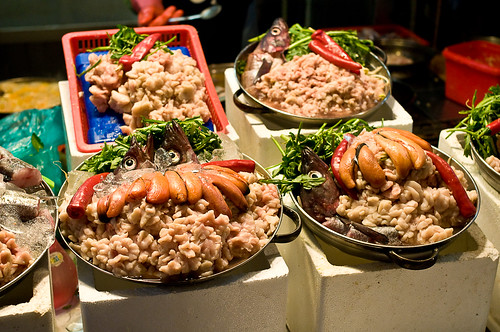
These are seafood restaurant displays (with real fish and its organs) by the sidewalk, which are supposed to look appetizing so that they attract customers. We didn't get to try these, but there were several people checking on these displays and going into the restaurant. I want to give it a try next time we go to Korea.
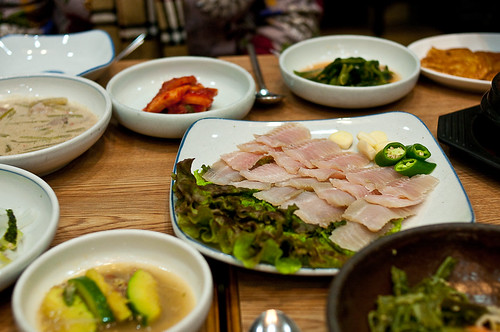
Fermented skate must be one of the hard-to-eat dish if not hard-to-find. Andrew Zimmerman passed the live octopus test and all, but he still had the hardest time getting through this one. It stinks really bad. The worse it stinks, the higher the quality it is supposed to be. The one we tried was pretty bad, too. It is supposed to be very good for digestion given all the "good" bacteria in the fermented fish.

I had a hard time breathing when I tried fermented skate on the first day, but by the time it came close to when we left Korea, I have gotten used to it. A slice of fermented skate and pork belly wrapped in a piece of aged kimchi is the way to eat, famously known as samhap, meaning triple combination.

The most FAQ we received after the trip was what the best dish was among the foods we had in Korea. Our answer is chuetang, a fresh water eel soup, which is a local delicacy of the City of Namwon. This is not a really photogenic dish, but the taste beats all. It tastes somewhat like well-seasoned dwenjang jjigye with added fresh water fish spices. If you are in Namwon, be sure to visit Saejip. They make the best chuetang in the world!




3 comments:
omg you're back! yay! ^_^
i just had my dinner, but those picture makes my mouth watery.
Korean food is my favourite! I always read articles on different cultures at http://ratedbystudents.com/services/essaytigers Essaytiger posts a lot of recipes and interesting facts.
Post a Comment